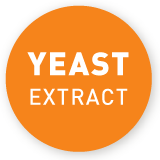Yeast extract is an ingredient used in food such as soups, sauces, ready meals and savoury snacks. It is made from the same fresh yeast that is used in bread, beer and wine production. Yeast extract is characterised by a savoury taste of its own and is used like a spice to round off the taste of food products.
What yeast extract contains
Yeast extract is made up of natural components from the yeast cell: proteins, amino acids, carbohydrates, vitamins and minerals. To produce yeast extract, the contents of the yeast cell are broken down by enzymes and the cell wall is removed. Simply put, yeast extract is made of natural components from the yeast cell without the surrounding cell wall. Among these components, it is primarily the mix of proteins and amino acids that provide yeast extract with its unique taste.
Yeast extract contains around 65% of protein. Since it is only used sparingly to refine dishes, yeast extract cannot cover the daily protein requirement. Nevertheless, it can contribute to the general protein content, for instance in a protein-rich diet. The protein quality of yeast extract is comparable to the reference proteins according to the Food and Agriculture Organization (FAO) in eggs or in milk. This means that yeast extract contains all the essential amino acids which are necessary for human nutrition in a very absorbable form. Yeast extract is not only a natural but also a safe ingredient. It is a non-genetically modified food product with a long history of safe use.
Did you know?
Protein and amino-acids are very important to create sumptuous taste in savoury foods. They create the taste of ripe tomatoes, ripened cheese and cooked meat.
How yeast extract adds flavour
Yeast extract is a food ingredient that contains a lot of taste-providing components and is used in many different dishes and products. For example, in the UK and commonwealth countries yeast extract is a popular spread for sandwiches.
Thanks to its natural components coming from its basis, fresh yeast, yeast extract contains a rich mix of protein compounds. Because of the similarity in the amino acid profile, the taste of yeast extract is comparable to a homemade bouillon. One of the components that is responsible for this unique hearty – or umami – taste is an amino acid called glutamic acid, which is not only naturally present in yeast and yeast extract but also cheese, tomatoes or soy sauce.
Glutamic acid is completely natural and should not be confused with monosodium glutamate (MSG), which is a flavour enhancer and an isolated pure substance of 100% sodium salt of glutamic acid.
Why yeast extract is sustainable
Yeast extract is not only a natural ingredient, but also a sustainable one. This is because by-products from other areas of food production are used and also the by-products that are generated during yeast extract production are reused. Take a look at our video to learn more.




